Gaggenau RT 220-202 User Manual

b
O
b
R
9000 144 207 (8602)
2

de |
In altsverze c n s . . . . . . . . . . . . . 4. . . . . . . . |
|||
|
|
|
|
|
|
|
|
|
|
en |
Table of Contents. . . . . . . . . . . . . .17. . . . . . . |
|||
|
|
|
||
|
|
|
||
fr |
Somma re . . . . . . . . . . . . . . . . 30. . . . . . . . . . . . |
|||
|
|
|
||
|
|
|
||
t |
Ind ce . . . . . . . . . . . . . . . . . . 44. . . . . . . . . . . . . . |
|||
|
|
|
||
|
|
|
||
nl |
In oud . . . . . . . . . . . . . . . . . .57. . . . . . . . . . . . . |
|||
|
|
|
||
|
|
|
||
es |
Índ ce . . . . . . . . . . . . . . . . . . 70. . . . . . . . . . . . . . |
|||
|
|
|
|
|
3

Inhaltsverzeichnis
Hinweise zur Entsorgung. . . . . . . . . . . . .5 . . . . . .
Sicherheits6 und Warnhinweise. . . . . . . . . .5 . . .
Gerät kennenlernen. . . . . . . . . . . . . . 7. . . . . . . . . .
Bedienblende . . . . . . . . . . . . . . . . 8. . . . . . . . . . . . .
Raumtemperatur und Belüftung beachten. . . . 8
Gerät anschließen . . . . . . . . . . . . . . .9 . . . . . . . . . .
Gerät einschalten. . . . . . . . . . . . . . . 9. . . . . . . . . . .
Temperatur einstellen. . . . |
. . . . . . . |
. |
. 9. . . . . . . . . |
Lebensmittel einordnen. . . |
. . . . . . . |
. |
. 10. . . . . . . . |
Ausstattung des Kühlraums. |
. . . . . . . |
. |
. .10. . . . . |
Das Gefrierfach. . . . . . . |
. . . . . . . |
. |
.11. . . . . . . . . . . . |
Tiefkühlkost lagern und Eis bereiten. . . . . . . . 11. Lebensmittel eingefrieren. . . . . . . . . . . .1 . . . . . . .
Max. Gefriervermögen . . . . . . . . . . . . 1. . . . . . . . .
Gefriergut auftauen. . . . . . . . . . . . . .13. . . . . . . . . .
Gerät ausschalten. . . . . . . . . . . . . . 13. . . . . . . . . . .
Gefrierfach abtauen. . . . . . . . . . . . . .13. . . . . . . . . .
Gerät reinigen. . . . . . . . . . . . . . . . 14. . . . . . . . . . . . .
Energie sparen. . . . . . . . . . . . . . . .14. . . . . . . . . . . .
Betriebsgeräusche . . . . . . . . . . . . . .14. . . . . . . . . . .
Kleine Störungen selbst beheben. . . . . . . . .15. .
Kundendienst . . . . . . . . . . . . . . . .16. . . . . . . . . . . . .
4
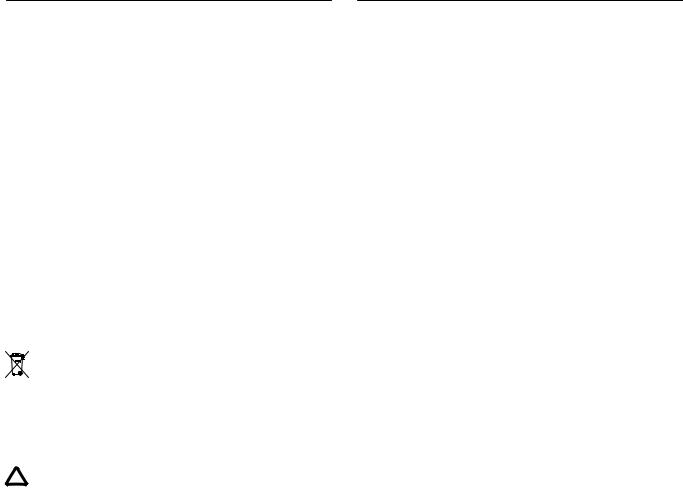
Hin is |
ur |
Entsorgung |
|
|
|
|
Si h rh its" un W rnhin is |
|
|
|
||||||||||||||||
V rp kung |
ntsorg n |
|
|
|
|
B vor Si |
s |
rät |
in B tri b |
n hm n |
||||||||||||||||
/+ $+75')0:3- |
8).C9>9 .7 +7A9 ;47 "7'3854798).A*+3+8+3 |
!/+ |
+(7':).8D |
:3* 439'-+'31+/9:3- |
|
|
||||||||||||||||||||
11+ +/3-+8+9>9+3 '9+7/'1/+3 8/3* :2<+19;+797A-1/). :3*':,2+708'2 *:7). |
|
|
|
|
|
|
|
|
|
|||||||||||||||||
</+*+7 ;+7<+79('7 |
/99+ .+1,+3 |
!/+ 2/9 39847-+3 !/+!/+*/++39.'19+3 |
</).9/-+ |
3,472'9/43+3 C(+7 :,89+11+3 |
||||||||||||||||||||||
$+75')0:3- :2<+19-+7+).9 |
|
|
|
|
|
+(7':). |
:3* |
%'79:3- *+8 +7A9+8 |
|
|
|
|
||||||||||||||
|
|
|
|
|
|
|
|
|
|
|
+<'.7+3 |
!/+ |
'11+ |
#39+71'-+3 |
,C7 |
85A9+7+3 |
+(7':). |
|||||||||
?(+7 '09:+11+ 39847-:3-8<+-+ /3,472/+7+3 |
!/+ 8/). (/99+4*+7 ,C7 ').(+8/9>+7 |
':, |
|
|
|
|
|
|
|
|||||||||||||||||
(+/ .7+2 ')..A3*1+7 4*+7 (+/ *+7 +2+/3*+D |
|
|
|
|
|
|
|
|
|
|
|
|
|
|
|
|||||||||||
;+7<'19:3- |
|
|
|
|
|
|
|
|
T hnis h Si h rh it |
|
|
|
|
|
|
|||||||||||
Altg rät |
|
ntsorg n |
|
|
|
|
|
|
'8 |
|
+7A9 |
+39.A19 /3 -+7/3-+7 +3-+ *'8 :2<+19D |
||||||||||||||
|
|
|
|
|
|
|
|
|
|
|
|
,7+:3*1/).+ |
'(+7 |
(7+33('7+ |
A19+2/99+1 |
|
600' |
|
||||||||
19-+7A9+ |
8/3* 0+/3 |
<+79148+7 (,'11 |
|
|
|
|
|
).9+3 |
!/+ |
*'7':, |
*'88 */+ |
4.7+ |
*+8 A19+2/99+1D |
|||||||||||||
:7). :2<+19-+7+).9+ 39847-:3- 0B33+3 |
<+79;411+ |
|
7+/81':,+8 |
(+/ "7'385479 4*+7 439'-+ |
3/).9 |
(+D |
||||||||||||||||||||
4.894,,+ |
</+*+7-+<433+3 <+7*+3 |
|
|
|
|
|
8).A*/-9 <+7*+3 |
|
|
|
|
|
|
|
|
|||||||||||
|
|
|
|
|
|
|
|
|
|
|
|
+7':8857/9>+3*+8 A19+2/99+1 0'33 >: :-+3;+7D |
||||||||||||||
|
/+8+8 +7A9 |
/89 +39857+).+3* |
*+7 |
+:745A/8).+3 |
1+9>:3-+3 |
,C.7+3 |
4*+7 |
8/). |
+39>C3*+3 |
|
|
|
||||||||||||||
|
/).91/3/+ 00 6 C(+7 1+0974D :3* 1+0974D |
|
|
|
|
|
|
|
|
|
|
|
|
|
|
|
||||||||||
|
3/0'19-+7A9+ <'89+ +1+)97/)'1 '3* +1+)9743/) |
B i |
|
B s hä igung |
|
|
|
|
|
|
|
|
||||||||||||||
|
|
|
|
|
|
|
|
|
|
|||||||||||||||||
|
|
|
|
|
|
|
|
|
|
|||||||||||||||||
|
+6:/52+39 |
% -+0+33>+/).3+9 |
/+ |
/).91/3/+ |
|
|
|
|
|
|
|
|
|
|
|
|
|
|
|
|||||||
|
-/(9 |
*+3 |
|
'.2+3 ,C7 +/3+ #D<+/9 |
-C19/-+ C)0D |
,,+3+8 |
+:+7 |
4*+7 &C3*6:+11+3 ;42 |
+7A9 |
,+73D |
||||||||||||||||
|
3'.2+ :3* |
|
$+7<+79:3- *+7 19-+7A9+ ;47 |
.'19+3 |
|
|
|
|
|
|
|
|
|
|
|
|||||||||||
|
W rnung |
|
|
|
|
|
|
|
|
|
+9>89+)0+7 >/+.+3 |
|
|
|
|
|
|
|
||||||||
|
|
|
|
|
|
|
|
|
|
|
|
|
|
|
|
|
|
|
|
|
|
|
|
|||
+/ |
':8-+*/+39+3 |
+7A9+3 |
|
|
|
|
|
|
':2 ,C7 |
+/3/-+ |
/3:9+3 |
-:9 |
*:7).1C,9+3 |
|
|
|||||||||||
|
|
|
|
|
|
|
|
|
|
|
|
|
|
|
|
|
|
|
|
|
||||||
|
+9>89+)0+7 |
>/+.+3 |
|
|
|
|
|
|
:3*+3*/+389 |
(+3').7/).9/-+3 |
|
|
|
|
|
|||||||||||
|
|
|
|
|
|
|
|
|
|
|
|
|
|
|
|
|
|
|
|
|
|
|||||
|
38).1:880'(+1 |
*:7).97+33+3 |
:3* |
2/9 |
*+2 |
|
|
+ |
2+.7 |
A19+2/99+1 /3 +/3+2 +7A9 |
/89 |
:284 |
-7B@+7 |
|||||||||||||
|
|
|
2:88 |
*+7 |
':2 8+/3 |
/3 *+2 |
*'8 |
+7A9 |
89+.9 3 >: |
|||||||||||||||||
|
+9>89+)0+7 |
+39,+73+3 |
|
|
|
|
|
|
||||||||||||||||||
|
|
|
|
|
|
|
01+/3+3 |
|
A:2+3 |
0'33 |
(+/ |
+/3+2 +)0 |
+/3 |
(7+33('7+8 |
||||||||||||
|
|
|
|
|
|
|
|
|
|
|
|
|
||||||||||||||
A19+-+7A9+ +39.'19+3 A19+2/99+1 |
:3* |
/3 *+7 |
841/+7:3- |
'8D :,9D +2/8). +3989+.+3 |
|
|
|
|
|
|||||||||||||||||
|
|
|
|
|
|
|
|
|
|
|
|
|
|
|
||||||||||||
'8+ A19+2/99+1 |
:3* '8+ 2C88+3 |
,').-+7+).9 +39847-9 |
74 |
|
|
- |
A19+2/99+1 2:88 |
*+7 |
|
|
|
|
|
|||||||||||||
<+7*+3 |
4.7+ |
*+8 A19+2/99+1D 7+/81':,+8 |
(/8 |
>:7 |
|
|
|
':2 2/3*+89+38 1 2 |
||||||||||||||||||
|
|
-74@ |
8+/3 |
/+ |
+3-+ |
*+8 |
A19+2/99+18 |
.7+8 +7A9+8 |
||||||||||||||||||
,').-+7+).9+3 39847-:3- 3/).9 |
(+8).A*/-+3 |
|
|
|
||||||||||||||||||||||
|
|
|
89+.9 |
':, |
*+2 |
"=58)./1* /2 33+7+3 |
*+8 +7A9+8 |
|||||||||||||||||||
|
|
|
|
|
|
|
|
|
|
|
|
|||||||||||||||
|
|
|
|
|
|
|
|
|
|
|
|
'8 %+).8+13 *+7 +9>'38).1:881+/9:3- :3* '3*+7+ |
||||||||||||||
|
|
|
|
|
|
|
|
|
|
|
|
+5'7'9:7+3 |
*C7,+3 |
3:7 |
;42 :3*+3*/+389 |
*:7).D |
||||||||||
|
|
|
|
|
|
|
|
|
|
|
|
-+,C.79 <+7*+3 #38').-+2A@+ 389'11'9/43+3 :3* |
||||||||||||||
|
|
|
|
|
|
|
|
|
|
|
|
+5'7'9:7+3 0B33+3 *+3 +3:9>+7 +7.+(1/). -+D |
||||||||||||||
|
|
|
|
|
|
|
|
|
|
|
|
,A.7*+3 |
|
|
|
|
|
|
|
|
|
|
|
|||
5
Beim Gebrauch |
Kinder im Haushalt |
ie elektrische Geräte innerhalb des Gerätes Verpackung und deren Teile nicht indern überB
verwenden z. . Heizgeräte elektrische EisB bereiter usw.
Explosionsgefahr!
ie das Gerät mit einem Dampfreinigungsgerät abtauen oder reinigen Der Dampf kann an elektrische Teile gelangen und einen urzschluss auslösen.
Stromschlaggefahr!
eine Produkte mit brennbaren Treibgasenz. . Spraydosen und keine explosiven Stoffe lagern.
Explosionsgefahr!
lassen. Erstickungsgefahr durch Faltkartons und Folien
|
Das |
Gerät ist kein Spielzeug für inder |
|
ei |
Gerät mit Türschloss Schlüssel außer Reichweite |
|
von |
indern aufbewahren |
Allgemeine Bestimmungen
Das Gerät eignet sich
zum ühlen und Gefrieren von ebensmitteln
|
zur Eisbereitung. |
Sockel uszüge Türen usw. nicht |
als Trittbrett oder |
zum bstützen missbrauchen. |
Das Gerät ist nur für die Verwendung im Haushalt |
|
bestimmt. |
Zum btauen und Reinigen etzstecker ziehen oder
|
Sicherung ausschalten. |
|
|
|
Das |
Gerät ist funkentstört |
nach |
EUBRichtlinie |
||||||
|
m |
etzstecker |
ziehen |
nicht |
am |
nschlusskabel. /336/EEC. |
|
|
|
|
|
|||
|
Hochprozentigen |
lkohol |
nur |
dicht |
verschlossen undDer |
ältekreislauf |
ist |
auf |
Dichtheit |
geprüft. |
||||
|
stehend |
lagern. |
|
|
|
|
|
|
|
|
|
|
|
|
|
|
|
|
|
|
|
|
Dieses Erzeugnis |
entspricht den |
einschlägigen SicherB |
||||
|
unststoffBTeile |
und Türdichtung nicht |
mit Öl oder heitsbestimmungen |
für |
Elektrogeräte |
E 60335/2/24 . |
||||||||
|
Fett verschmutzen. unststoffBTeile und Türdichtung |
|
|
|
|
|
|
|||||||
|
werden sonst porös. |
|
|
|
|
|
|
|
|
|
|
|||
|
eB |
und |
Entfüftungsöffnungen |
für |
das |
Gerätnie |
|
|
|
|
|
|
||
|
abdecken |
oder |
zustellen. |
|
|
|
|
|
|
|
|
|
|
|
Im Gefrierraum keine Flüssigkeiten in Flaschen und Dosen lagern besonders kohlensäurehaltige
Getränke . Flaschen und Dosen können platzen
ie Gefriergut sofort nachdem es aus dem Gefrierraum genommen wird in den und nehmen.
Gefrierverbrennungsgefahr!
Vermeiden Sie längeren ontakt der Hände mit dem Gefriergut Eis oder den Verdampferrohren usw.
Gefrierverbrennungsgefahr!
Reifschicht und festgefrorenes Gefriergut nicht mitesser oder spitzem Gegenstand abschaben.
Sie könnten damit die ältemittelrohre beschädigen. Herausspritzendes ältemittel kann sich entzünden oder zu ugenverletzungen führen.
6
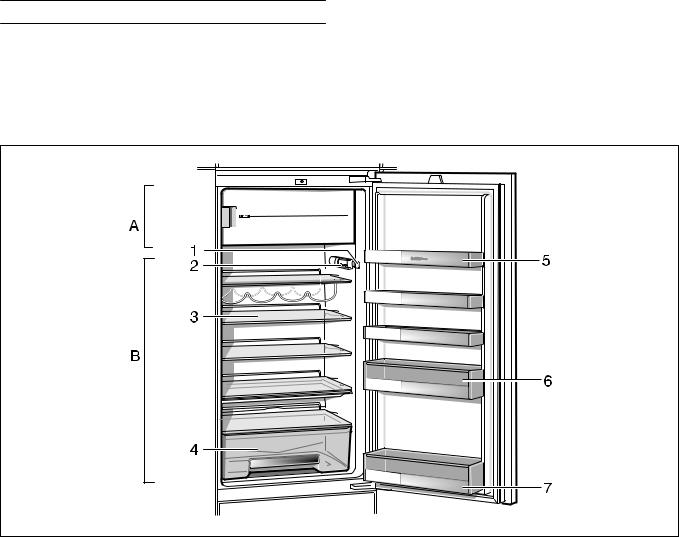
Gerät kennenlernen
Diese Gebrauchsanweisung gilt für mehrere Modelle. Abweichungen bei den Abbildungen sind möglich.
Beispiel für eine Ausst ttung
1Lichtschalter
2Bedienblende/Innenbeleuchtung
3 Ablagen im Kühlraum
4Gemüsebehälter
5 |
Ablage |
für |
Eier |
6 |
Ablage für |
Tuben und kleine Dosen |
|
7 |
Ablage |
für |
große Flaschen |
AGefrierfach
BKühlraum
7
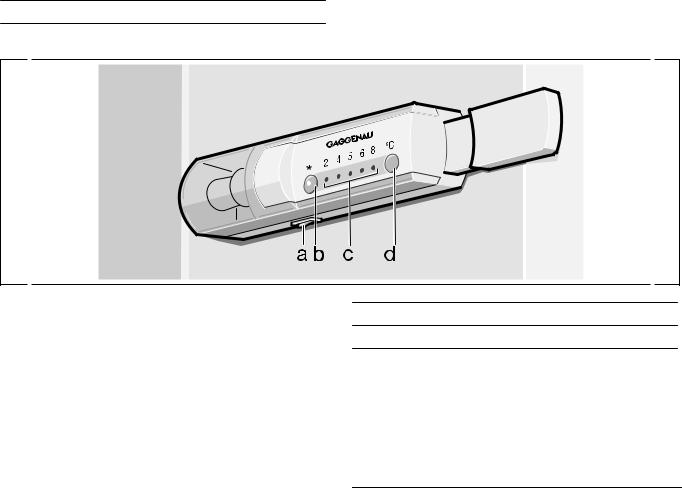
Bedienblende
2a Hauptschalter Ein/Aus
Geräte;Hauptschalter, dient zum Ein; und Ausschalten des gesamten Gerätes.
Raumtemperatur und Belüftung
beachten
2b Superkühlen$Taste |
|
Die Klimaklasse steht auf dem Typenschild. |
Sie |
gibt an, |
|
innerhalb welcher Raumtemperaturen das Gerät betrie; |
|||
|
|
|||
Das leuchtende Lämpchen |
|
ben werden kann. Das Typenschild befindet |
sich |
links |
zeigt die Inbetriebnahme |
|
|
||
an. Beim Superkühlen wird der Kühlraum |
unten im Kühlraum. |
|
|
|
|
|
|
||
ca. 6 Stunden lang, so kalt wie möglich gekühlt. |
|
|
|
|
Danach wird automatisch |
auf die vor dem |
|
|
|
Superkühlen eingestellte Temperatur umgestellt.
Das Superkühlen einschalten z. B.:
Vor dem Einlegen großer Mengen frischer Lebensmitteln.
Zum Schnellkühlen von Getränken.
2c Temperaturanzeige$Lämpchen
Die Zahlen bei den Temperaturanzeige;Lämpchen zeigen die Kühlraum;Temperaturen °Cin an
Das Lämpchen blinkt, wenn die eingestellte Temperatur noch nicht erreicht ist.
2d Temperatur$Einstelltaste
Von +8°C bis +2°C einstellbar.
Taste so oft drücken, bis gewünschtes Temperatur;Lämpchen leuchtet.
Der zuletzt eingestellte Wert wird gespeichert.
Klimaklasse |
zulässige |
Raumtemperatur |
|
|
|
|
|
SN |
+10 °C |
bis |
32°C |
|
|
|
|
N |
+16 °C |
bis |
32°C |
|
|
|
|
ST |
+18 °C |
bis |
38°C |
|
|
|
|
T |
+18 °C |
bis |
43°C |
|
|
|
|
Belüftung
Die |
Luft an |
der |
Rückwand des Geräts erwärmt sich. |
||
Die erwärmte |
Luft |
muss |
ungehindert abziehen |
können. |
|
Die |
Kühlmaschine |
muss |
sonst mehr leisten. |
Dies erhöht |
|
den |
Stromverbrauch. |
|
|
||
Daher: Nie Be; und Entlüftungsöffnungen abdecken oder zustellen
8
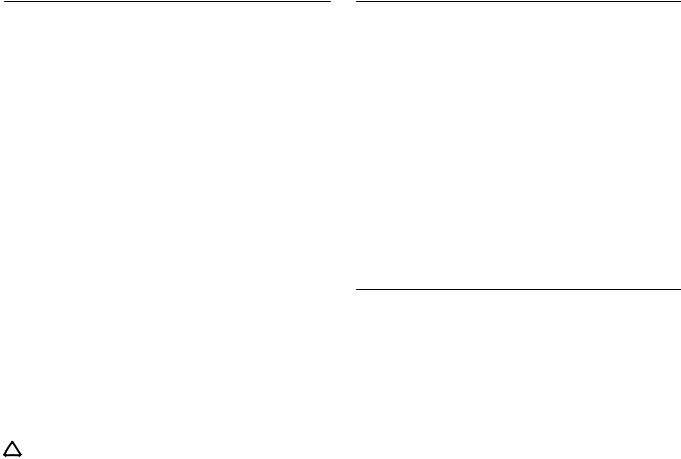
Gerät |
anschließen |
|
|
|
|
Gerät |
einschalten |
|
|
Nach dem Aufstellen des |
Gerätes mindestens ½ StundeEin Aus=Schalter 2a drücken Innenbeleuchtung |
||||||||
warten bis das Gerät in Betrieb genommen wird |
|
leuchtet Temperaturanzeige=Lämpchen blinkt |
|||||||
Während |
des Transports kann |
es vorkommen dass |
sich |
|
|
|
|||
das im |
Verdichter enthaltene |
Öl im Kältesystem verlagertVom |
Werk aus hat der Kühlraum eine Grundeinstellung |
||||||
|
|
|
|
|
|
von |
+5 ºC |
||
Vor der ersten Inbetriebnahme den Innenraum des |
|
|
|
|
|
||||
Gerätes reinigen (sieheGerät |
reinigen) |
|
Wir empfehlen eine Einstellung von +4 ºC |
||||||
Die Steckdose sollte frei |
zugänglich sein |
|
Empfindliche Lebensmittel sollten nicht wärmer als +4 ºC |
||||||
Das Gerät an 0 40 V 50 Hz Wechselstrom über |
|
gelagerteine |
werden |
||||||
vorschriftsmäßig installierte Steckdose anschließen |
|
|
|
|
|
||||
Die Steckdose muss mit einer 10=A=Sicherung oder |
|
|
|
|
|
||||
höher abgesichert sein |
|
|
|
|
|
|
|
|
|
|
|
|
|
|
|
|
|
||
Bei Geräten, die in nicht6europäischen Ländern betrieben werden, ist auf dem Typenschild zu überprüfen, ob die angegebene Spannung und Stromart mit den Werten Ihres Stromnetzes übereinstimmt. Das Typenschild befindet sich im Kühlraum links unten. Ein eventuell notwendiger
Temperatur einstellen
Die Einstellwerte können geändert werden siehe Beschreibung zur Bedienblende
Hinweise zum Betrieb
Austausch der Netzanschlussleitung darf nur durch |
|
|
|
einen Fachmann erfolgen. |
Die |
Kühlraum6Temperatur |
wird wärmer: |
Warnung! |
|
durch häufiges Öffnen |
der Geräte=Tür |
Auf keinen Fall darf das Gerät an elektronische Energiesparstecker und an Wechselrichter, die Gleichstrom in 230 V Wechselstrom umwandeln, angeschlossen werden (z.B. Solaranlagen, Schiffsstromnetze).
durch Einlegen großer Mengen Lebensmittel
Tauwasser6Tropfen oder Reif im Kühlraum
Während die Kühlmaschine läuft bilden sich an der Rückwand des Kühlraums Tauwasser=Tropfen oder Reif Dies ist funktionsbedingt
Sie brauchen die Tauwasser=Tropfen oder den Reif nicht abzuwischen Die Rückwand taut automatisch ab
Das Tauwasser läuft in die Ablauf=Rinne Von der Ablauf= rinne läuft das Tauwasser zur Kühlmaschine wo es ver= dunstet
9
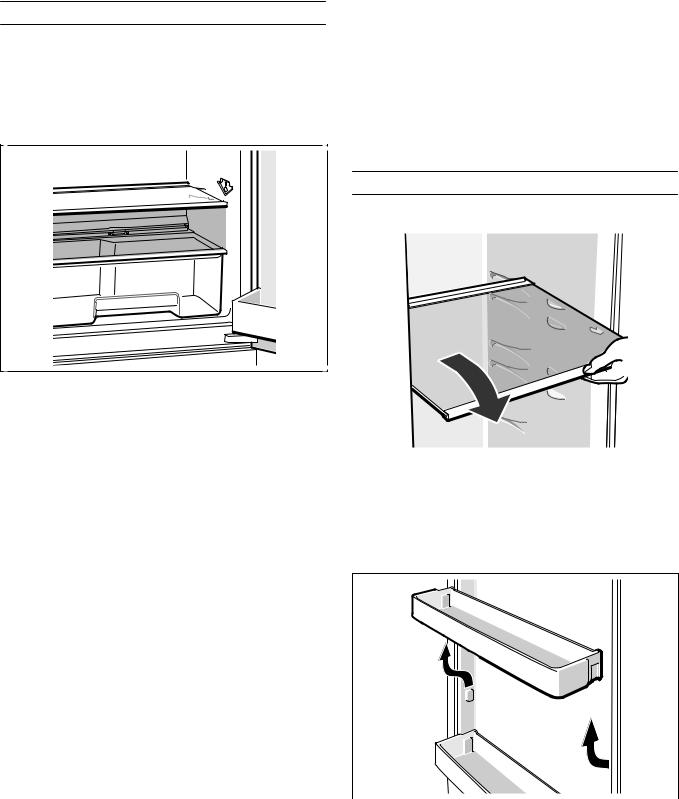
Lebensmittel einordnen
Kälte(Zonen im Kühlraum beachten! Nutzinhalt
Durch die Luft5Zirkulation im Kühlraum entstehen ZonenDie Angaben zum Nutzinhalt finden Sie in Ihrem Gerät au unterschiedlicher Kälte: dem Typenschild.
Ausstattung des Kühlraums
Kälteste |
Zone |
|
|
|
|
|
|
|
|
|
|
|
|
|
|
|
|
|
|
||
|
|
|
|
|
|
|
|
|
||
|
|
|
|
|
|
|
|
|
||
|
|
|
|
|
|
|
|
|
||
|
|
|
|
|
|
|
|
|
||
|
|
|
|
|
|
|
|
|
||
ist zwischen dem seitlich eingeprägtem Pfeil und |
der |
|
|
|
|
|
||||
darunter |
liegenden |
Glasablage. |
|
|
|
|
|
|
||
|
|
|
|
|
|
|
|
|
|
|
Hinweis: |
Lagern Sie in den kältesten Zonen empfind5 |
|
|
|
|
|
||||
liche Lebensmittel, |
(z. B. Fisch, Wurst, Fleisch). |
Sie können |
die |
Ablagen |
des Innenraums und die |
|||||
|
|
|
|
|
Türablagen |
nach |
Bedarf |
variieren: |
||
Wärmste Zone
ist an der Tür ganz oben. Ablage nach vorne ziehen, absenken und seitlich
|
|
herausschwenken. |
Hinweis: |
Lagern sie |
in der wärmsten Zone z. B. Käse |
und Butter. Beim Servieren behält der Käse sein |
||
Aroma, |
die Butter |
bleibt streichfähig. |
Beim Einordnen beachten
Lebensmittel gut verpackt oder abgedeckt einordnen.
Dadurch bleiben Aroma, Farbe und Frische erhalten.
Außerdem werden Geschmacksübertragungen und
Verfärbungen der Kunststoffteile vermieden.
Wir empfehlen, die Lebensmittel wie folgt einzuordnen:
|
Im |
Gefrierfach: Tiefkühlkost, Eiswürfel, |
Speiseeis. |
|
|
||||
|
Auf den Ablagen im Kühlraum(von oben nach |
Türablage anheben und herausnehmen. |
||
|
||||
|
unten): Backwaren, fertige Speisen, Molkerei5 |
|
||
|
Produkte, Fleisch und Wurst. |
|
|
|
|
Im |
Gemüsebehälter: Gemüse, Salat, |
Obst. |
|
In der Tür(von oben nach unten): Butter, Käse, Eier, Tuben, kleine Flaschen, große Flaschen, Milch, Safttüten.
1
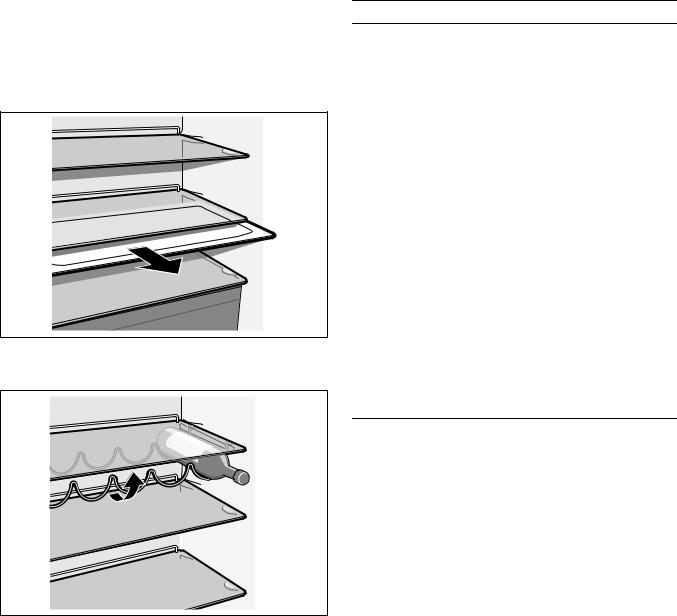
Sonderausstattung
nicht bei allen Modellen
Servierschale |
Flaschenablage |
Das Gefrierfach
(-18 °C und kälter)
Das Gefrierfach verwenden
Zum Lagern von Tiefkühlkost
Zum Herstellen von Würfeleis
Zum Einfrieren kleiner Mengen Lebensmittel
Hinweis:
Die Gefrierfach9Tür rastet hörbar ein
Achten Sie darauf dass die Gefrierfach9Tür immer
geschlossen ist Bei offener Tür |
taut das Gefriergut auf |
Das Gefrierfach vereist stark |
|
Außerdem: Energieverschwendung |
durch hohen |
Stromverbrauch |
|
Tiefkühlkost lagern und Eis bereiten
Beachten Sie bereits beim Einkauf von Tiefkühlkost:
Überprüfen Sie die Verpackung ob sie beschädigt ist
Überprüfen Sie das Haltbarkeits9Datum
Die Kühlraumtemperatur in der Verkaufstruhe muss kälter als 18 °C sein Wenn nicht verkürzt sich die Haltbarkeit der Tiefkühlkost
In der |
Flaschenablage können Flaschen sicher abgelgt |
Tiefkühlkost |
ganz zum Schluss |
einkaufen |
|||
werden |
Wird der Platz |
für |
andere |
Lebensmittel benötigt Tiefkühlkost |
in Zeitungspapier oder in einer |
||
können |
die Metallbügel |
nach |
oben |
geklappt werden |
Kühltasche nach Hause transportieren |
||
|
|
|
|||||
|
|
|
|
|
Zuhause Tiefkühlkost sofort in |
das Gefrierfach legen |
|
|
|
|
|
|
Gefrierraum9Tür sorgfältig schließen Tiefkühlkost vor |
||
|
|
|
|
|
Ablauf des |
Haltbarkeits9Datums |
aufbrauchen |
Aufgetaute Lebensmittel nicht wieder einfrieren Ausnahme: Wenn Sie die Lebensmittel zu einem Fertiggericht verarbeiten kochen oder braten dann können Sie dieses Fertiggericht erneut einfrieren
11
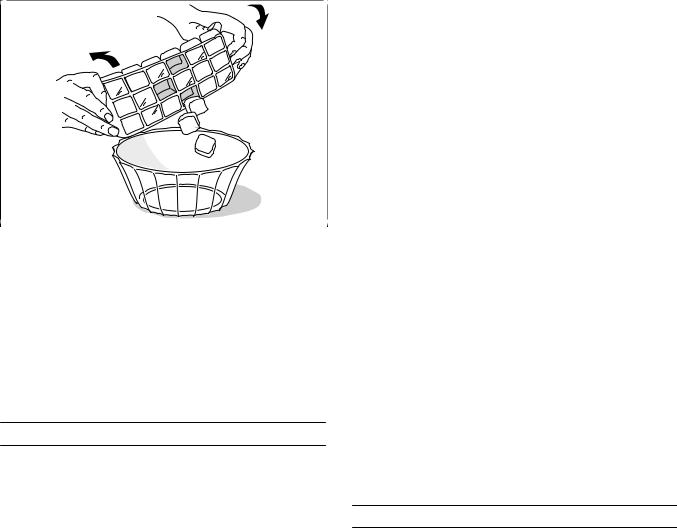
Eiswürfel herstellen
Als Verpackung ungeeignet sind:
Packpapier, Pergamentpapier, Cellophan, Müllbeutel, gebrauchte Einkaufstüten.
Als Verpackung geeignet sind:
Kunststoff<Folien, Schlauch<Folien aus Polyethylen, Alu<Folien, Gefrierdosen.
Sie finden diese Produkte im Fachhandel.
Zum Verschließen geeignet sind:
Gummiringe, Kunststoff<Klippse, Bindfäden, Kältebeständige Klebebänder o. ä.
|
|
|
Sie |
können Beutel und Schlauchfolien aus Polyethylen |
|
Eisschale ¾ mit |
|
mit |
einem Folien<Schweißgerät verschweissen. |
|
Wasser füllen und auf den Boden |
|
||
|
des Gefrierraums |
stellen. |
|
|
Haltbarkeit des Gefriergutes
Festgefrorene Eisschale nur mit stumpfem Gegenstand lösen (Löffelstiel).
Hängt ab von der Art der Lebensmittel. Bei mittlerer Temperatur:
Zum Lösen der Eiswürfel Eisschale kurz unter
fließendes Wasser halten oder leicht verwinden. Fisch, Wurst, fertige Speisen, bis zu6 Monate
Lebensmittel eingefrieren
Backwaren |
|
Käse, Geflügel, Fleisch |
bis 8zuMonate |
Gemüse, Obst |
bis zu12 Monate |
Verwenden Sie zum Einfrieren nur frische und einwandfreie Lebensmittel.
Max. Gefriervermögen
Lebensmittel luftdicht verpacken, damit sie nicht den Geschmack verlieren oder austrocknen.
So verpacken Sie richtig
1. Lebensmittel in die Verpackung einlegen.
2.Luft völlig herausdrücken.
3.Packung dicht verschließen.
4.Verpackung beschriften mit Inhalt und Einfrier< Datum.
Lebensmittel sollen möglichst schnell bis zum Kern durchgefroren werden. Nur so bleiben Vitamine, Nährwert, Aussehen und Geschmack erhalten.
Das max. Gefriervermögen Ihres Gerätes deshalb nicht überschreiten.
Angaben über das max. Gefriervermögen in 24 Stunden finden Sie auf dem Typenschild.
12
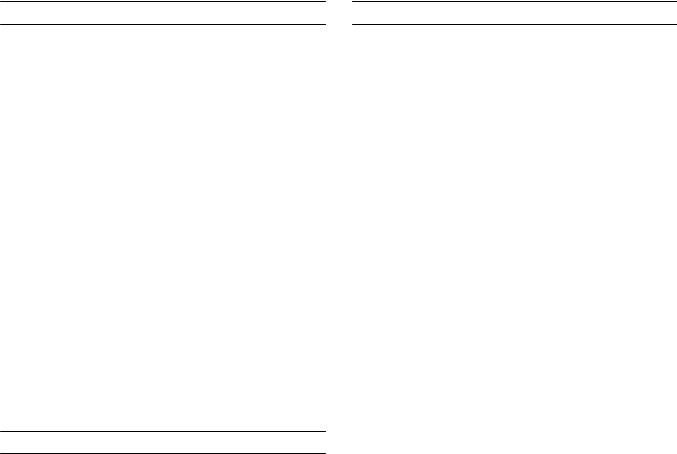
Gefriergut auftauen
im elektrischen Backofen mit/ohne Heißluftventilatorspitzem Gegenstand abschaben. Sie könnten damit die
im Mikrowellengerät. |
Kältemittel@Rohre |
beschädigen. Herausspritzendes |
|
Kältemittel |
kann |
sich entzünden oder zu Augenver@ |
|
|
letzungen |
führen. |
|
Hinweis |
|
|
|
An@ |
oder |
|
|
|
Gehen Sie wie folgt vor |
|||
aufgetautes Gefriergut nicht wieder eingefrieren. |
|
|
||||||
Erst |
nach |
dem Verarbeiten zu |
einem |
Fertiggericht |
1. |
Gefriergut entnehmen und an einem kühlen Ort |
||
gekocht oder gebraten kann |
es erneut eingefroren |
|||||||
|
zwischenlagern. |
|||||||
werden. |
|
|
|
|
||||
|
|
|
|
|
|
|||
Die |
max. |
Lagerdauer des Gefriergutes |
nicht mehr voll2. |
Netzstecker |
ziehen oder Sicherung auslösen. |
|||
nutzen. |
|
|
|
3. |
Tür offen lassen. Tauwasser mit Tuch oder |
|||
|
|
|
|
|
||||
|
|
|
|
|
|
Schwamm |
aufwischen. |
|
Gerät ausschalten
Ein/Aus@Schalter 2a drücken. Temperaturanzeige@Lämpchen erlischt damit ist die Kühlung und Beleuchtung ausgeschaltet.
Gerät stilllegen
Wenn Sie das Gerät längere Zeit nicht benutzen:
Netzstecker ziehen oder Sicherung ausschalten.
Gerät reinigen.
Geräte@Tür offen lassen.
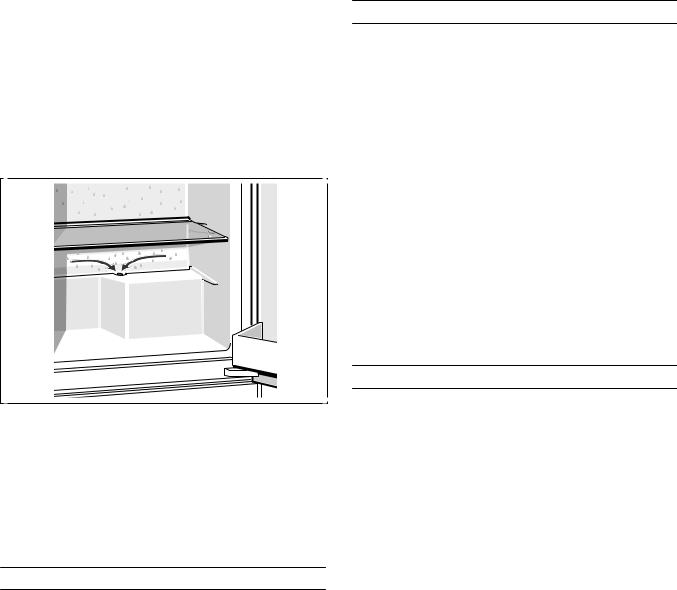
Energie sparen
Kühlraum taut vollautomatisch ab |
|
Während die Kühlmaschine läuft, bilden sich an der Rückwand des Kühlraums Tauwasser5Tropfen oder Reif. Dies ist funktionsbedingt. Sie brauchen die Tauwasser5 Tropfen oder den Reif nicht abzuwischen.
Gerät in einem trockenen, belüftbaren Raum auf5
stellen; nicht |
direkt |
in |
der |
Sonne oder in der Nähe |
|
einer |
Wärmequelle |
(z. |
B. |
Heizkörper, Herd). |
|
Sonst |
eine |
Isolierplatte |
verwenden. |
||
Die Rückwand taut automatisch ab. Das Tauwasser läuft |
normale Geräusche |
|
|||||
|
Ganz |
|
|||||
in die Tauwasser5Rinne. Von der |
Tauwasser5Rinne läuft |
|
|
|
|
|
|
das Tauwasser zur Kühlmaschine, |
wo es verdunstet. |
Das Brummen |
kommt |
vom Motor |
(Kompressor). |
||
Hinweis: Tauwasser5Rinne und Ablauf5Loch sauber5 |
Es kann kurzfristig etwas lauter |
werden, wenn sich |
|||||
der |
Motor einschaltet. |
|
|
|
|||
halten, damit das Tauwasser ablaufen kann. |
|
|
|
|
|
|
|
|
|
Das Blubbern, |
Gurgeln |
oder |
Surrenkommt vom |
||
|
|
Kältemittel, das |
durch |
die Rohre |
fließt. |
||
Gerät reinigen
Achtung: Netzstecker ziehen oder Sicherung ausschalten!
Das Klicken ist immer dann zu hören, wenn der Thermostat den Motor ein5 oder ausschaltet.
Geräusche, die sich leicht beheben lassen
Die |
Türdichtung nur mit klarem Wasser abwischen |
und |
danach gründlich trockenreiben. |
Reinigen Sie das Gerät mit lauwarmem Wasser und etwas Spülmittel. Das Spülwasser darf nicht in die Bedienblende oder Beleuchtung gelangen.
Nach dem Reinigen: Gerät wieder anschließen und einschalten.
Verwenden Sie keine sandhaltigen oder säurehaltigen Putz5 und Lösungsmittel.
Tauwasser5Rinne und Ablaufloch regelmäßig mit Stäbchen oder ähnlichem reinigen, damit das Tauwasser ablaufen kann. Tauwasser5Rinne mit Stäbchen o. ä. reinigen.
Das |
Reinigungswasser darf nicht durch das Ablaufloch in |
die |
Verdunstungsschale laufen. |
14
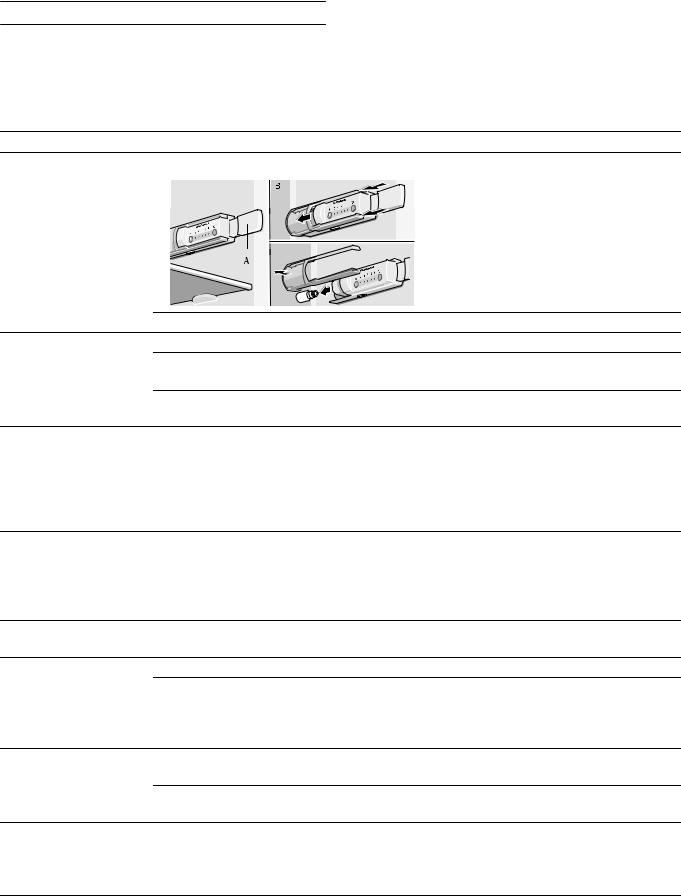
Kleine Störungen selbst beheben
Bevor Sie den Kundendienst rufen:
Überprüfen Sie ob Sie die Störung aufgrund der folgenden Hinweise selbst beheben können
Sie müssen die Kosten für Beratung durch den Kundendienst selbst übernehmen auch während der Garantiezeit
Störung |
|
|
|
Mögliche |
Ursache |
|
Abhilfe |
|
|
|
|
|
|
|||||
Die |
Innen.Beleuchtung |
Die |
Glühlampe |
ist |
defekt |
|
Glühlampe |
austauschen: |
|
|
||||||||
funktioniert |
nicht. |
|
|
|
|
|
|
1 Netzstecker ziehen bzw Sicherung |
||||||||||
|
|
|
|
|
|
|
|
|
|
|
|
ausschalten |
|
|
|
|
|
|
|
|
|
|
|
|
|
|
|
|
|
|
Lampenabdeckung B nach |
hinten |
|||||
|
|
|
|
|
|
|
|
|
|
|
|
abziehen |
|
|
|
|
|
|
|
|
|
|
|
|
|
|
|
|
|
|
Glühlampe |
wechseln: |
Ersatzlampe |
||||
|
|
|
|
|
|
|
|
|
|
|
|
0 40 V |
Wechselstrom |
Sockel E14 |
||||
|
|
|
|
|
|
|
|
|
|
|
|
Wattangabe siehe defekte Lampe |
||||||
|
|
|
|
|
Der LichtschalterA klemmt |
|
Prüfen ob |
er sich bewegen lässt |
||||||||||
Temperaturanzeige. |
Häufiges Öffnen der Geräte>Tür |
Tür nicht unnötig öffnen |
|
|
||||||||||||||
Lämpchen |
blinkt |
Es |
wurden viele |
Lebensmittel |
eingelegt |
Superkühlen |
vor dem |
Einlegen |
||||||||||
(im Gerät zu warm). |
|
|
|
|
|
|
einschalten |
|
|
|
|
|
|
|||||
|
|
|
|
|
Die Be> und Entlüftungsöffnungen sind |
Hindernisse |
entfernen |
|
|
|
||||||||
|
|
|
|
|
verdeckt |
|
|
|
|
|
|
|
|
|
|
|
|
|
Das |
Gefriergut |
ist |
|
|
|
|
|
|
Gefriergut mit |
einem |
stumpfen |
|||||||
festgefroren. |
|
|
|
|
|
|
|
Gegenstand |
lösen |
|
|
|
|
|||||
|
|
|
|
|
|
|
|
|
|
|
Nicht mit Messer oder spitzem |
|||||||
|
|
|
|
|
|
|
|
|
|
|
Gegenstand ablösen Sie könnten damit |
|||||||
|
|
|
|
|
|
|
|
|
|
|
die |
Kältemittel>Rohre |
oder |
die |
|
|||
|
|
|
|
|
|
|
|
|
|
|
Kunststoff>Oberfläche |
|
beschädigen |
|||||
Das |
Gefrierfach |
hat |
|
|
|
|
|
|
Gefrierfach abtauen siehe Abtauen |
|||||||||
eine |
dicke |
Reifschicht. |
|
|
|
|
|
|
Achten Sie immer darauf dass die |
|||||||||
|
|
|
|
|
|
|
|
|
|
|
Gefrierfach>Tür |
richtig |
schließt |
|
||||
|
|
|
|
|
|
|
|
|
|
|
Die |
Gefrierfach>Tür |
muss |
hörbar |
||||
|
|
|
|
|
|
|
|
|
|
|
einrasten |
|
|
|
|
|
|
|
Der |
Boden |
des |
Kühl. |
Das |
Tauwasser>Ablaufrohr ist |
verstopft |
Reinigen Sie die Tauwasserrinne und das |
|||||||||||
raums ist |
nass. |
|
|
|
|
|
|
Ablaufrohr sieheGerät reinigen |
||||||||||
Die |
Temperatur |
im |
Temperatur ist zu kalt eingestellt |
Temperatur |
wärmer |
einstellen |
|
|||||||||||
Kühlraum |
ist zu kalt. |
Durch das Einfrieren größerer Mengen |
fri>Max Gefriervermögen nicht überschreiten |
|||||||||||||||
|
|
|
|
|
scher Lebensmittel sinkt die |
Temperatur siehe Max. |
Gefriervermögen |
|
||||||||||
|
|
|
|
|
im Kühlraum vorübergehend da die Kälte> |
|
|
|
|
|
|
|
||||||
|
|
|
|
|
maschine |
lange |
läuft |
|
|
|
|
|
|
|
|
|
||
Die |
Kältemaschine |
Einfrieren |
größerer |
Mengen frischer |
Max Gefriervermögen |
nicht überschreiten |
||||||||||||
schaltet |
immer |
häufiger Lebensmittel |
|
|
|
siehe Max. |
Gefriervermögen |
|
||||||||||
und |
länger |
ein. |
|
Die Be> und Entlüftungsöffnungen sind |
Hindernisse |
entfernen |
|
|
|
|||||||||
|
|
|
|
|
verdeckt |
|
|
|
|
|
|
|
|
|
|
|
|
|
Der Kühlschrank hat keine Kühlleistung.
Ein Aus>Schalter |
ist |
nicht eingeschaltet |
Ein Aus>Schalter drücken |
|
|
|
|
|
|
Stromausfall; die |
Sicherung |
ist ausge> |
Prüfen ob Strom vorhanden ist; |
|
schaltet; |
|
|
|
Sicherungen überprüfen |
der Netzstecker |
sitzt |
nicht |
fest |
|
15
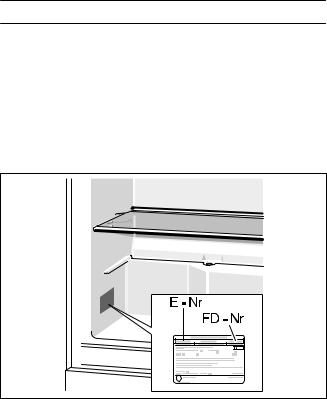
Kundendienst
Einen Kundendienst in Ihrer Nähe finden Sie im Telefonbuch oder im Kundendienst*Verzeichnis. Geben
Sie bitte dem Kundendienst die |
Erzeugnisnummer (E*Nr.) |
und die Fertigungsnummer (FD) |
des Gerätes an. |
Sie finden diese Angaben auf Typenschilddem .
Bitte helfen Sie durch Nennung der Erzeugnis* und Fertigungsnummer mit, unnötige Anfahrten zu vermeiden. Sie sparen die damit verbundene Mehrkosten.
16

Table of Contents
Information concerning disposal. . . . . . . . .18. . .
Safety and warning information. . . . . . . . . .18. . .
Getting to know your appliance. . . . . . . . . . .0. .
Fascia . . . . . . . . . . . . . . . . . . . .1 . . . . . . . . . . . . . . . .
Observe ambient temperature
and ventilation . . . . . . . . . . . . . . . . 1. . . . . . . . . . . .
Connecting the appliance. . . . . . . . . . . . . . . . . .
Switching on the appliance. . . . . . . . . . . . . . . . .
Selecting the temperature. . . . . . . . . . . . . . . . . .
Storing food in the appliance. . . . . . . . . . . .3 . . .
Interior fittings of refrigerator compartment. . |
3 |
|
The freezer compartment. . . . . . . . . . . |
. .4 . . . . . . |
|
Storing deep/frozen food and making ice. . . . |
4 |
|
Freezing |
food. . . . . . . . . . . . . . . . |
. 5. . . . . . . . . . . . |
Max. freezing capacity. . . . . . . . . . . . . .5 . . . . . . . |
||
Thawing |
frozen food. . . . . . . . . . . . . |
. .6 . . . . . . . . |
Switching |
off the appliance. . . . . . . . . . |
. . 6. . . . . |
Defrosting the freezer compartment. . . . . . . . 6.
Cleaning the appliance. . . . . . . . . . . . . .7 . . . . . . .
Tips for |
saving energy. . . . . . . . . . . . . . .7 . . . . . . . |
|||
Operating |
noises. . |
. |
. . . . |
. . . . . . . . .7 . . . . . . . . . . |
Eliminating minor faults yourself. . . . . . . . . .8. . |
||||
Customer |
service. . |
. |
. . . . |
. . . . . . . . .9 . . . . . . . . . . |
17
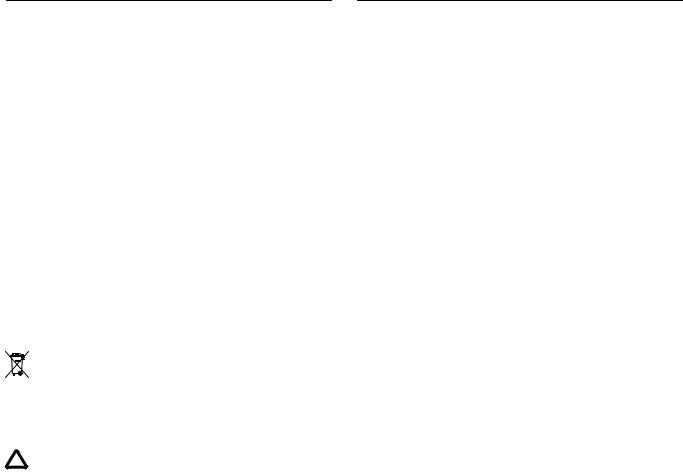
Inform tion concerning dispos l |
|
S fety nd w rning inform tion |
|
||||
Dispos l of |
p ck ging |
Before you switch ON the ppli nce |
|||||
The packaging protects your appliance from damage |
Please read the operating and installation instructions |
||||||
during transit. All packaging materials are environmentallycarefully. |
|||||||
friendly and recyclable. Please contribute to a better |
They contain important information on how to install, |
||||||
environment by disposing of packaging materials in anuse and maintain the appliance. |
|||||||
environmentally7friendly |
manner. |
Keep |
all documentation for subsequent use or for the |
||||
|
|
|
|
|
next |
owner. |
|
Please |
ask your dealer |
or inquire at your local authority |
|
|
|||
about |
current means |
of |
disposal. |
Technic l s fety |
|||
Dispos l of your old ppli nce
Old appliances are not worthless rubbish |
|
|||
Valuable raw materials can |
be reclaimed by |
recycling |
||
old appliances. |
|
|
||
|
This appliance has been identified in |
accordance |
||
|
with the European directive 2002/96/EG on Waste |
|||
|
Electrical and Electronic Equipment 8 WEEE). |
|||
|
||||
|
||||
|
The |
directive specifies |
the framework for an EU7 |
|
|
wide |
valid return and |
recycling of old |
appliances. |
W rning
Redundant appliances:
If d m ge |
h s occurred |
|
Keep |
naked flames and/or ignition sources away |
|
from |
the |
appliance. |
Pull out the mains plug.
Thoroughly ventilate the room for several minutes.
Notify customer service.
Pull |
out |
the |
mains |
plug. |
|
|
|
|
The |
more refrigerant an appliance contains, the larger |
|||||
|
|
|
|
|
|
|
|
|
|
||||||
Cut |
off |
the |
power |
cord and |
discard |
with the |
mains |
the |
room must be |
in |
which |
the appliance is situated. |
|||
Leaking refrigerant |
can |
form |
a flammable gas7air |
||||||||||||
plug. |
|
|
|
|
|
|
|
|
|
mixture in rooms which are too small. |
|||||
|
|
|
|
|
|
|
|
|
|
||||||
Refrigerators |
contain |
refrigerants |
and the |
insulation |
|
|
|
|
3 |
|
|
||||
|
|
|
|
|
|
|
|
|
|
The room must be at leastper1 m8 g of refrigerant. |
|||||
contains |
gases. |
Refrigerant and |
gases |
must be disposed The |
amount of refrigerant in |
your |
appliance is |
||||||||
of properly. |
Ensure |
that tubing of the |
refrigerant |
circuit |
is |
|
|
|
inside |
the appliance. |
|||||
not damaged prior |
to |
proper disposal. |
|
|
|
indicated on the rating plate |
|||||||||
|
|
|
|
|
|
|
|
|
|||||||
|
|
|
|
|
|
|
|
|
|
Only |
customer service may change the power cord |
||||
|
|
|
|
|
|
|
|
|
|
and |
carry out any other repairs. Improper installations |
||||
|
|
|
|
|
|
|
|
|
|
and |
repairs may put |
the user at considerable risk. |
|||
18
Impo an info ma ion when ing he Child en in he ho ehold appliance
|
|
|
Neve use electrical |
appliances |
inside the refrigerator |
e.g. heater electric |
ice maker |
etc. . |
Keep children away from packaging and |
its parts. |
anger of suffocation from folding cartons |
and plastic |
film |
|
Explo ion haza d!
o not allow children to play with the appliance
Neve use a steam cleaner to defrost or clean the
appliance. |
The |
|
If the |
appliance features a lock keep the key out |
steam may penetrate electrical parts |
|
|||
and cause |
a |
short6circuit. |
of the reach of children. |
|
|
|
|||
Ri k of elec ic hock! |
Gene al |
eq i emen |
||
|
|
|
||
o not store products which contain flammable
propellants e. g. spray |
cans or |
|
|
|
The |
appliance |
is |
suitable |
|
|
|
|||||||
explosive substances |
|
|
|
|
|
|
|
|
|
|
||||||||
in |
the |
appliance. |
|
|
|
|
|
for |
refrigerating |
and |
freezing |
food |
|
|||||
Explo ion haza d! |
|
|
|
|
|
|
||||||||||||
o not stand or support yourself on the base |
|
for |
making |
ice. |
|
|
|
|
|
|||||||||
drawers |
or doors etc. |
|
|
|
The |
appliance |
is |
designed |
for |
domestic |
use. |
|||||||
|
|
|
|
|
|
|
|
|||||||||||
Before |
defrosting |
and |
cleaning |
the |
appliance |
pull |
out |
|
|
|
|
|
|
|
|
|
|
|
the |
mains plug |
or switch off |
the |
fuse. |
|
The |
appliance has been interference6suppressed in |
|||||||||||
o |
not |
pull out |
the |
mains plug by tugging |
the |
compliance with U |
irective /336/ C. |
|||||||||||
cable. |
|
|
|
|
|
|
|
|
|
|||||||||
|
|
|
|
|
|
|
|
The |
refrigerant |
circuit |
has |
been |
tested |
for leaks. |
||||
Bottles which contain a high percentage of alcohol |
|
|
|
|
|
|
|
|
|
|
||||||||
must be sealed |
and |
stored in |
an |
upright position. |
|
|
|
|
|
|
|
|
|
|
||||
|
|
|
|
|
|
|
|
This product |
complies |
with |
the |
relevant |
safety regulations |
|||||
|
|
|
|
|
|
|
|
for |
electrical |
appliances |
N 60335/2/24 . |
|
||||||
Keep plastic parts and the door seal free of oil and grease. Otherwise parts and door seal will become porous.
Neve cover or block the ventilation openings for the appliance.
o not store bottled or canned drinks especially carbonated drinks in the freezer compartment. Bottles and cans may explode
Neve put frozen food straight from the freezer
compartment into your mouth.
Ri k of low# empe a e b n !
Avoid prolonged touching of frozen food ice or the
evaporator pipes etc.
Ri k |
of |
low# empe a e |
b n ! |
||
o |
not |
scrape off |
hoarfrost or |
stuck frozen food with |
|
a knife |
or pointed |
object. |
|
||
You could damage the refrigerant tubing. Leaking |
|||||
refrigerant may ignite or |
cause |
eye injuries. |
|||
19
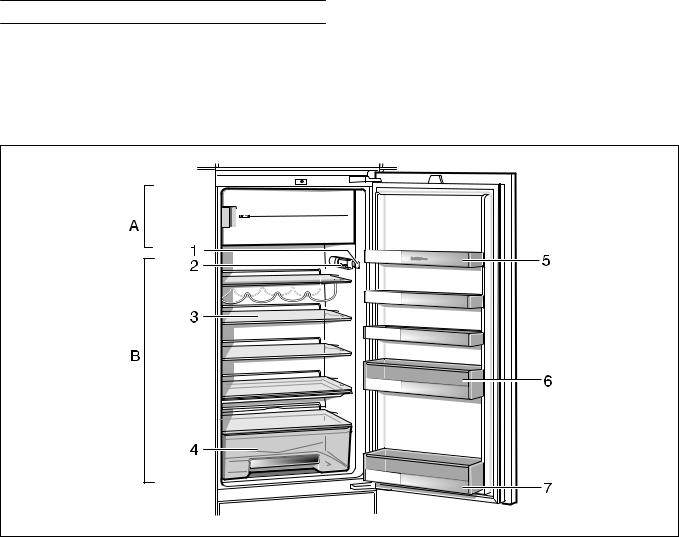
G ttin to know your applianc
These operating |
instructions refer to several models. |
The illustrations |
may differ. |
Exampl o atur s
1Light switch
2Fascia/Interior light
3 Shelf in the refrigerator compartment
4Vegetable container
5Egg rack
6 |
Shelf |
for |
tubes |
and small tins |
7 |
Shelf |
for |
large |
bottles |
AFreezer compartment
B Refrigerator compartment
20
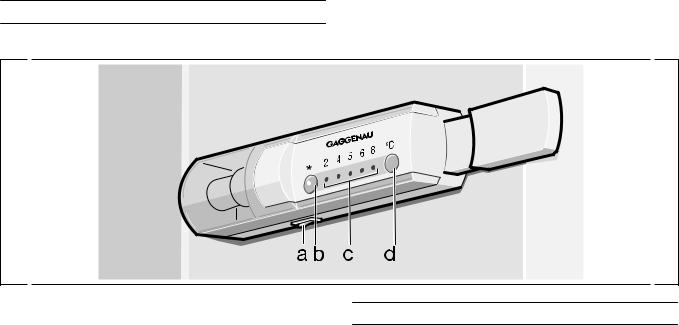
Fascia
2a Main On/Off switch
Observe ambient temperature
|
|
|
|
|
|
|
|
|
|
and venti ation |
|
|
|
|
|
|
|
|
|
|
|
||
|
Appliance main switch is used to switch the whole |
|
|
|
|
|
|
|
|
|
|
|
|
|
|||||||||
|
appliance |
on |
and |
off. |
|
|
|
|
|
|
|
|
|
|
|
|
|
|
|
|
|
||
2b |
Super |
coo ing |
button |
|
|
|
The climatic |
class can |
be found |
on |
the rating |
plate |
and |
||||||||||
|
|
|
indicates the |
ambient |
temperatures |
at |
which the |
|
applian. |
||||||||||||||
|
|
|
|
|
|
|
|
|
|
|
|||||||||||||
|
When the |
light |
is |
on, |
super cooling has started. |
ce can be operated. The rating plate |
|
is located |
|
|
in |
the r |
|||||||||||
|
Super |
|
|
|
|
|
|
|
|
|
|
|
|
|
|||||||||
|
|
|
|
|
|
|
|
|
|
frigerator compartment at the bottom left.hand side. |
|
||||||||||||
|
cooling cools the refrigerator compartment as cold as |
|
|
|
|
|
|
|
|
|
|
|
|
|
|||||||||
|
possible |
for |
approx. 6 |
|
hours. Then the |
temperature |
|
|
|
|
|
|
|
|
|
|
|
|
|
||||
|
set before |
super |
mode |
is automatically |
restored. |
|
|
|
|
|
|
|
|
|
|
|
|
|
|
||||
|
|
|
|
|
|
|
|
|
|
|
|
|
|
|
|
|
|||||||
|
Switch |
on |
super |
mode, |
e.g.: |
|
C imatic c ass |
Permitted |
ambient |
temperature |
|
|
|||||||||||
|
|
|
|
|
|
|
|
|
|
|
|
|
|
|
|
||||||||
|
|
S |
|
+10 °C |
to |
32°C |
|
|
|
|
|
|
|
||||||||||
|
|
|
|
|
|
|
|
|
|
|
|
|
|
|
|
|
|
||||||
|
|
|
|
|
|
|
|
|
|
|
|
|
|
|
|
|
|
|
|
|
|
||
|
|
|
|
|
|
|
|
|
|
|
|
+16 °C |
to |
32°C |
|
|
|
|
|
|
|
||
|
before placing large quantities of fresh food in the |
|
|
|
|
|
|
|
|
|
|
|
|
|
|||||||||
|
appliance, |
|
|
|
|
|
|
|
ST |
|
+18 °C |
to |
38°C |
|
|
|
|
|
|
|
|||
|
|
|
|
|
|
|
|
|
|
|
|
|
|
|
|
|
|
|
|
|
|
||
|
to cool |
drinks |
quickly. |
|
|
|
T |
|
+18 °C |
to |
43°C |
|
|
|
|
|
|
|
|||||
|
|
|
|
|
|
|
|
|
|
|
|
|
|
|
|
|
|
||||||
|
|
|
|
Venti ation |
|
|
|
|
|
|
|
|
|
|
|
|
|||||||
2c |
Temperature |
disp ay |
amp |
|
|
|
|
|
|
|
|
|
|
|
|
|
|||||||
|
|
|
|
|
|
|
|
|
|
The air on |
the |
rear panel |
of |
the |
appliance heats |
up. |
|||||||
|
The numbers next to the temperature display lights |
|
|
|
|
|
|
|
|
|
|
|
|
|
|||||||||
|
indicate |
the |
refrigerator |
|
compartment temperatures |
The warm air must be |
able |
to |
escape. |
Otherwise, |
the |
||||||||||||
|
° |
|
|
|
|
|
|
|
|
refrigerator must |
work |
harder. |
This will |
increase |
the |
|
|||||||
|
in C |
|
|
|
|
|
|
|
|
power consumption. |
|
|
|
|
|
|
|
|
|
|
|
||
|
|
|
|
|
|
|
|
|
|
|
|
|
|
|
|
|
|
|
|
|
|||
|
The light flashes until the selected temperature is Therefore: Never |
cover |
or |
block ventilation openings |
|
||||||||||||||||||
|
reached. |
|
|
|
|
|
|
|
|
|
|
|
|
|
|
|
|
|
|
|
|
|
|
2d Temperature se ection button
can be set between °C+8and +2°C.
Press the button until the required temperature lamp illuminates.
The value last selected is stored.
21

Connecting |
the appliance |
|
|
Switching |
on |
the |
appliance |
|
After installing the appliance wait at least. ½ hour |
beforePress the On/Off switch2a. Interior light comes on |
|||||||
switching on the |
appliance. During transportation the |
|
temperatureoil indicator light |
flashes. |
||||
in the compressor may have flowed into the refrigeration |
|
|
|
|
||||
system. |
|
|
|
At the factory |
the |
refrigerator compartment was set to |
||
|
|
|
|
+5 °C. |
|
|
|
|
Before switching on the appliance for the first time clean the interior of the appliance Cleaning(see the
appliance).
We recommend a setting of +4 °C.
Perishable food should not be stored warmer than +4 °C.
The socket should be freely accessible. |
|
|
|
|
|
|
|
|
|
|
||
Connect the appliance to 2204240 V/50 Hz alternating |
|
|
|
|
|
|
|
|
|
|||
current via a correctly installed earthed socket. The |
|
|
|
|
|
|
|
|
|
|
||
Selecting |
the |
temperature |
|
|
||||||||
socket must |
be fused with a 10 A fuse or higher. |
|
|
|||||||||
If the appliance is to be operated in a non,European |
|
|
|
|
|
|
|
|
||||
country, check on the rating plate whether the |
The set values can be changed see Description of |
|||||||||||
indicated |
voltage and current type correspond to |
control panel: |
|
|
|
|
|
|
|
|||
the values of your mains supply. The rating plate is |
|
|
|
|
|
|
|
|
||||
located in the refrigerator compartment at the |
Operating |
tips |
|
|
|
|
|
|||||
bottom left,hand side. The power cord may be |
|
|
|
|
|
|
|
|
|
|
||
replaced |
by |
an electrician only. |
The |
refrigerator compartment |
temperature |
rises: |
||||||
Warning! |
|
|
if |
the appliance door is opened frequently |
||||||||
Never connect the appliance to electronic energy |
if |
large quantities of food are placed in |
the refrigerator |
|||||||||
saver plugs (e.g. Ecoboy: Sava Plug) or to power |
compartment. |
|
|
|
|
|
|
|||||
inverters which convert the direct current to 230 V |
|
|
|
|
|
|
|
|
|
|||
alternating current (e.g. solar equipment, power |
Condensation droplets or frost in the refrigerator |
|||||||||||
supplies |
on |
ships). |
compartment |
|
|
|
|
|
|
|
||
|
|
|
While |
the refrigerating unit is running beads of conden3 |
||||||||
|
|
|
sation or hoarfrost form at the back of the refrigerator |
|||||||||
|
|
|
compartment. |
This |
is |
quite |
normal. |
|
|
|||
|
|
|
It |
is |
not necessary |
to |
wipe |
off |
the condensation or frost. |
|||
|
|
|
The rear panel defrosts automatically. |
|
|
|||||||
|
|
|
The condensation runs into the drainage channel. and |
|||||||||
|
|
|
then |
to the |
refrigerating unit where it evaporates. |
|||||||
22
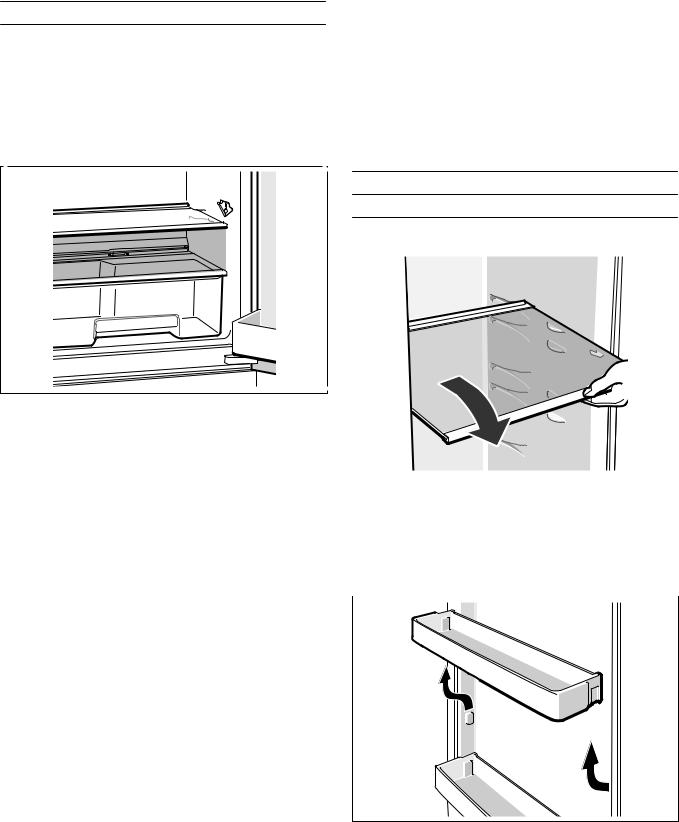
Storing food in the app iance
ote the refrigeration zones in the refrigerator compartment!
The air circulation in the refrigerator compartment produce different refrigerant zones:
Usab e |
capacity |
||
Information |
on |
the |
usable capacity can be found inside |
your appliance |
on |
the rating plate. |
|
nterior fittings of refrigerator
compartment
|
|
|
|
|
|
|
|
|
|
|
|
|
|
|
|
|
|
|
|
|
|
|
|
|
|
|
|
|
|
|
|
|
|
|
|
|
|
|
|
|
|
|
|
|
|
|
|
|
|
|
|
|
|
|
|
|
|
|
|
|
|
|
|
|
|
Co dest zone |
|
|
|
|
|
|
|
|||
is between the arrow stamped on the side and |
the |
|
|
|
|
|
|
|||
glass |
shelf situated below. |
|
|
|
|
|
|
|
||
|
|
|
|
|
|
|
|
|
|
|
Note: |
Store perishable food (eg. fish, sausage, meat) |
|
|
|
|
|
|
|||
in the |
coldest zones. |
You can |
vary |
the |
shelves |
inside the appliance and the |
||||
|
|
|
|
containers |
in |
the |
door to |
suit your requirements. |
||
Warmest zone
is at the very top of the door. |
|
Pull the shelf forwards, lower and swivel out |
||||
|
|
sideways. |
||||
Note: Store e. g. cheese and butter in the warmest |
||||||
zone. When served, the cheese will not have lost |
|
|
|
|
|
|
its |
|
|
|
|
||
|
|
|||||
flavour and the butter will be easy |
to spread. |
|
|
|||
P ease |
note |
|
|
|
|
|
Wrap or cover food before |
placing in |
the |
appliance. |
This |
||
will |
retain |
the aroma, colour |
and freshness |
of the food. |
||
In addition, flavours will not |
be transferred |
between |
foods |
|||
and |
the plastic parts will not become |
discoloured. |
|
|||
We |
recommend arranging |
the food |
as |
fo ows: |
|
|
n the freezer compartment:Frozen food, ice
cubes, ice cream
|
|
Raise the door shelf and remove. |
|
On the she ves in the refrigerator compartment |
|
|
(from top to bottom): cakes and pastries, ready |
|
|
meals, |
dairy products, meat and sausage |
|
n the |
vegetab e container:vegetables, salad, fruit |
In thedoor (from top to bottom): butter, cheese, eggs, tubes, small bottles, large bottles, milk, juice cartons
23
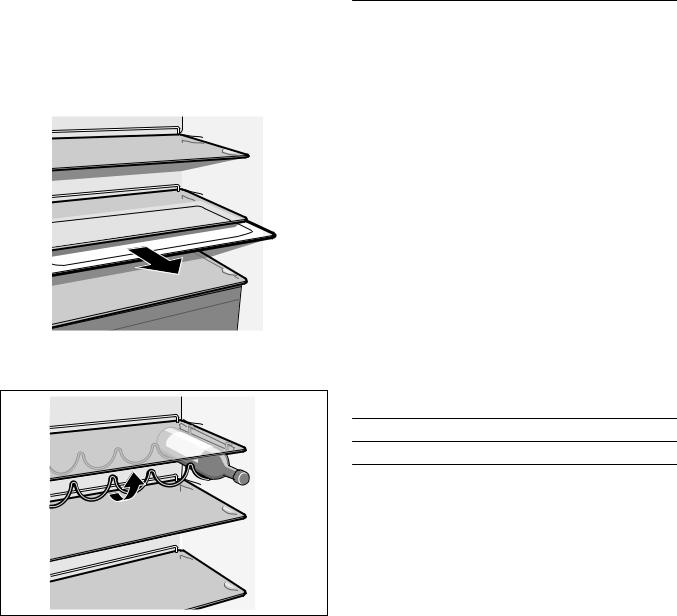
|
|
|
|
The |
|
freezer |
compartment |
|||||
Special features |
|
|
(-18 °C |
and |
colder) |
|
|
|||||
(not all |
models) |
|
|
Use |
|
the |
freezer |
compartment |
||||
|
|
|
|
|
||||||||
|
|
|
|
|
For |
storing |
deep1frozen food. |
|||||
|
|
|
|
|||||||||
|
|
|
|
|
For |
making |
ice cubes. |
|||||
|
|
|
|
|||||||||
|
|
|
|
|||||||||
|
|
|
|
|||||||||
|
|
|
|
For freezing small quantities of food. |
||||||||
|
|
|
|
|||||||||
|
|
|||||||||||
|
|
|||||||||||
|
|
|
|
Note: |
|
|
|
|
|
|
|
|
|
|
|
|
Freezer compartment door must "click" shut. |
||||||||
|
|
|
|
Ensure that the freezer compartment door has been |
||||||||
|
|
|
|
closed |
properly. |
If |
the |
door is open, the frozen food will |
||||
|
|
|
|
thaw. The freezer compartment will become covered in |
||||||||
|
|
|
|
thick |
ice. |
|
|
|
|
|
||
Serving |
tray |
|
|
Also: |
waste |
of |
energy |
due to high power consumption |
||||
Storing deep)frozen food
and making ice
When purchasing deep)frozen food, comply with the following:
Check that the packaging is not damaged.
Check the sell1by date.
The temperature of the supermarket freezer should
Bottle |
shelf |
be |
-18 °C |
or |
lower. |
If not, |
the |
storage |
life of the food |
is |
reduced. |
|
|
|
|
|
|||
|
|
|
|
|
|
|
|||
Bottles |
can be stored |
securely on the bottle shelf. If the |
|
|
|
|
|
|
|
space |
is required for |
other food, the metal frame can bePurchase |
deep1frozen |
food |
last. |
Wrap in |
newspaper |
||
folded |
up. |
or |
place |
in a |
cold bag and take home. |
||||
At home immediately place deep1frozen food in the freezer compartment. Close the freezer compartment door properly. Use the deep1frozen food before the
sell1by date runs out.
Do |
not refreeze thawed food. Exception: If you use |
the |
food to make a ready meal (boiling or frying), you |
can |
refreeze this ready meal. |
24
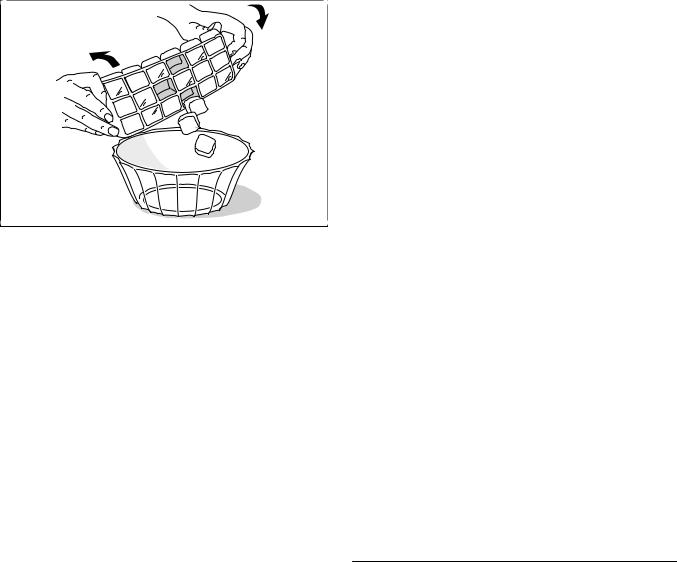
Making ice cubes
The following products are not suitable for wrapping food:
Wrapping paper, greaseproof paper, cellophane, refuse bags and used shopping bags.
The following products are suitable for wrapping food:
Plastic film, polyethylene blown film, aluminium foil and freezer tins.
These products can be purchased from your dealer.
The following products are suitable for sealing the wrapped food:
|
|
|
|
|
|
|
|
|
|
Rubber bands, plastic clips, string, |
cold2resistant |
||||||
|
Fill |
the |
|
ice tray ¾ full of water |
and place |
in theadhesivebottom |
tape or similar. |
|
|
|
|||||||
|
of |
the |
freezer compartment. |
|
|
|
|
Bags and polyethylene blown film can be sealed with |
|||||||||
|
|
|
|
|
|
|
|
|
|
||||||||
|
If the ice tray is stuck to the |
|
freezer compartment,a film sealer. |
|
|
|
|
|
|||||||||
|
loosen |
with a blunt implement |
only (spoon2handle). |
|
|
|
|
|
|
|
|||||||
|
|
|
|
|
|
|
|
|
|
Storage |
duration of the |
frozen |
food |
||||
|
To loosen the ice cubes, twist |
|
the ice tray slightly or |
|
|
|
|
|
|
|
|||||||
|
hold briefly under flowing |
water. |
|
|
|
Depends on the type of food. At |
a mean |
temperature: |
|||||||||
|
|
|
|
|
|
|
|
|
|
Fish, sausage, ready meals andup to6 months |
|||||||
|
|
|
|
|
|
|
|
|
|
cakes and |
pastries |
|
|
|
|
||
Freezing |
food |
|
|
|
|
|
|
|
|
||||||||
|
|
|
|
|
Cheese, |
poultry |
and |
meat |
up8 tomonths |
||||||||
|
|
|
|
|
|
|
|
|
|
||||||||
|
|
|
|
|
|
|
|
|
|
Vegetables |
and |
fruit |
up 12to months |
||||
|
Freeze |
fresh, undamaged |
food |
only. |
|
|
|
|
|
|
|
|
|
|
|||
|
To prevent food from losing its |
|
flavour or |
drying out, |
|
|
|
|
|
|
|
||||||
|
place in |
airtight containers. |
|
|
|
|
|
|
|
|
|
|
|
|
|||
|
|
|
|
|
|
|
|
|
|
Max. |
freezing |
capacity |
|
|
|
||
How to wrap food correctly
1. Place the food in the wrapping.
2. Press out all the air.
3.Seal the wrapping.
4.Label the wrapping with the contents and date.
In order to retain the vitamins, nutritional value, appearance and flavour food should be frozen as quickly as possible. Do not exceed the max. freezing capacity. freeze the food as quickly as possible.
Do not exceed the max. freezing capacity of your appliance.
Information about the max. freezing capacity within 24 hours can be found on the rating plate.
25

4 Wipe the freezer compartment dry
Switching |
off |
the |
appliance |
5 |
Switch |
on |
the |
appliance |
again |
|
|||||
|
|
|
|
|
|
|
|
||||||||
|
Press the |
On Off switch2a When |
the temperature |
6 |
Put the |
frozen |
food |
back |
in |
the freezer compartment |
|||||
|
|
|
|
|
|
|
|
|
|
||||||
|
display light goes out, refrigeration and light have Defrosting |
aids |
|
|
|
|
|||||||||
|
switched |
off |
|
|
|
|
|
|
|
|
|
|
|
|
|
Disconnecting |
the |
appliance |
You |
can accelerate |
the |
defrosting |
process by |
placing a |
|||||||
pan |
of hot water in the |
freezer |
compartment |
|
|||||||||||
|
|
|
|
|
|
|
|
||||||||
If |
the appliance is |
not used for a |
prolonged period: Attention: place |
the |
pan |
on |
a heat7insulating |
base |
|||||||
Pull out the mains plug or switch off the fuse
Cleaning the appliance
Leave the appliance door open
Warning: Never use electrical appliances or naked flames to defrost the freezer compartment, e g heaters, steam cleaners, candles, kerosene lamps, etc
Caution when using defrosting sprays:
Defrosting sprays may form explosive gases
Defrosting sprays may contain solvents or propellants
which attack plastic
Defrosting sprays may be a health hazard
Follow the manufacturer's instructions
26
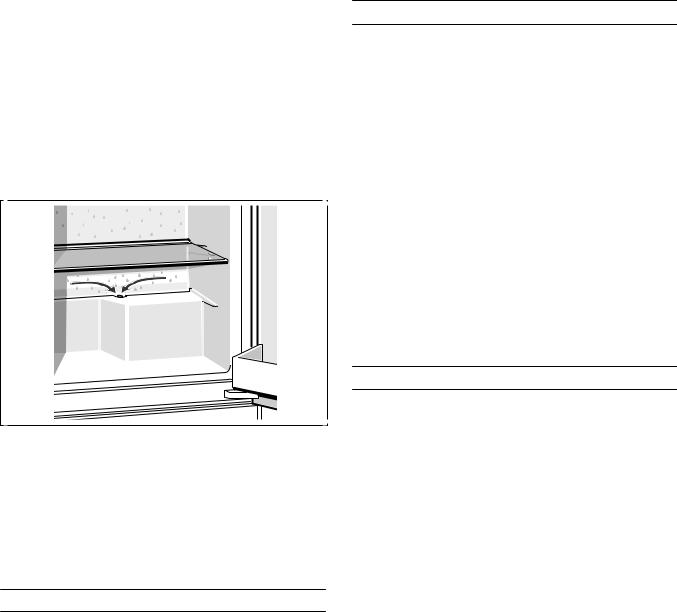
